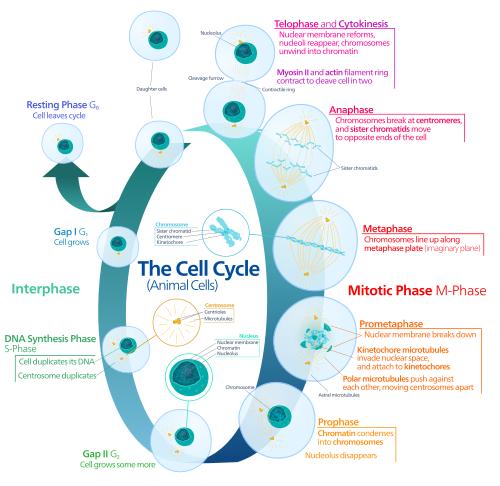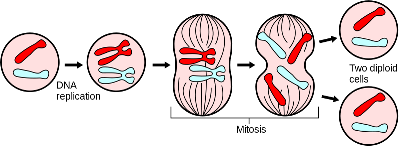How Long Does Cell Division Take In A Average Animal Or Plant Cell?
Science >> Biological science for Kids
Biological science for Kids
Jail cell Division and Cycle
Living organisms are constantly making new cells. They make new cells in lodge to abound and as well to replace old dead cells. The procedure by which new cells are fabricated is chosen cell division. Prison cell partitioning is occurring all the fourth dimension. Around two trillion cell divisions occur in the average human being trunk every 24-hour interval!Types of Cell Sectionalisation
In that location are three main types of cell division: binary fission, mitosis, and meiosis. Binary fission is used past simple organisms like leaner. More circuitous organisms gain new cells by either mitosis or meiosis.
Mitosis
Mitosis is used when a cell needs to exist replicated into exact copies of itself. Everything in the cell is duplicated. The two new cells take the same DNA, functions, and genetic code. The original cell is chosen the mother prison cell and the two new cells are called daughter cells. The full process, or cycle, of mitosis is described in more detail beneath.
Examples of cells that are produced through mitosis include cells in the homo body for the skin, claret, and muscles.
Cell Cycle for Mitosis
Cells get through different phases called the prison cell cycle. The "normal" state of a cell is called the "interphase". The genetic cloth is duplicated during the interphase stage of the cell. When a cell gets the bespeak that information technology is to duplicate, it volition enter the start state of mitosis called the "prophase".
- Prophase - During this phase the chromatin condenses into chromosomes and the nuclear membrane and nucleolus break downwardly.
- Metaphase - During metaphase the chromosomes line up along the middle of the cell.
- Anaphase - During anaphase the chromosomes separate and movement to opposite sides of the prison cell.
- Telophase - During telophase the cell forms 2 nuclear membranes around each set of chromosomes and the chromosomes uncoil. The prison cell walls then pinch off and split up downwards the middle. The ii new cells, or daughter cells, are formed. The splitting of the cells is chosen cytokinesis or jail cell cleavage.

Click on picture show for larger view
Meiosis is used when it is fourth dimension for the entire organism to reproduce. At that place are two chief differences betwixt mitosis and meiosis. First, the meiosis process has two divisions. When meiosis is complete, a single cell produces four new cells instead of but 2. The second divergence is that the new cells only have half the DNA of the original cell. This is important for life on Earth as information technology allows for new genetic combinations to occur which produces diversity in life.
Examples of cells that undergo meiosis include cells used in sexual reproduction called gametes.
Diploids and Haploids
The cells produced from mitosis are called diploids considering they accept two consummate sets of chromosomes.
The cells produced from meiosis are called haploids because they simply accept half the number of chromosomes equally the original cell.

Binary Fission
Simple organisms such as bacteria undergo a type of prison cell sectionalization chosen binary fission. First the Deoxyribonucleic acid replicates and the jail cell grows to twice its normal size. Then the duplicate strands of Deoxyribonucleic acid move to opposite sides of the cell. Next, the cell wall "pinches" off in the center forming two split cells.
Activities
- Accept a ten question quiz nigh this page.
- Listen to a recorded reading of this page:
More than Biology Subjects
Scientific discipline >> Biology for Kids
Source: https://www.ducksters.com/science/biology/cell_division.php
Posted by: sochahaphe1951.blogspot.com

0 Response to "How Long Does Cell Division Take In A Average Animal Or Plant Cell?"
Post a Comment